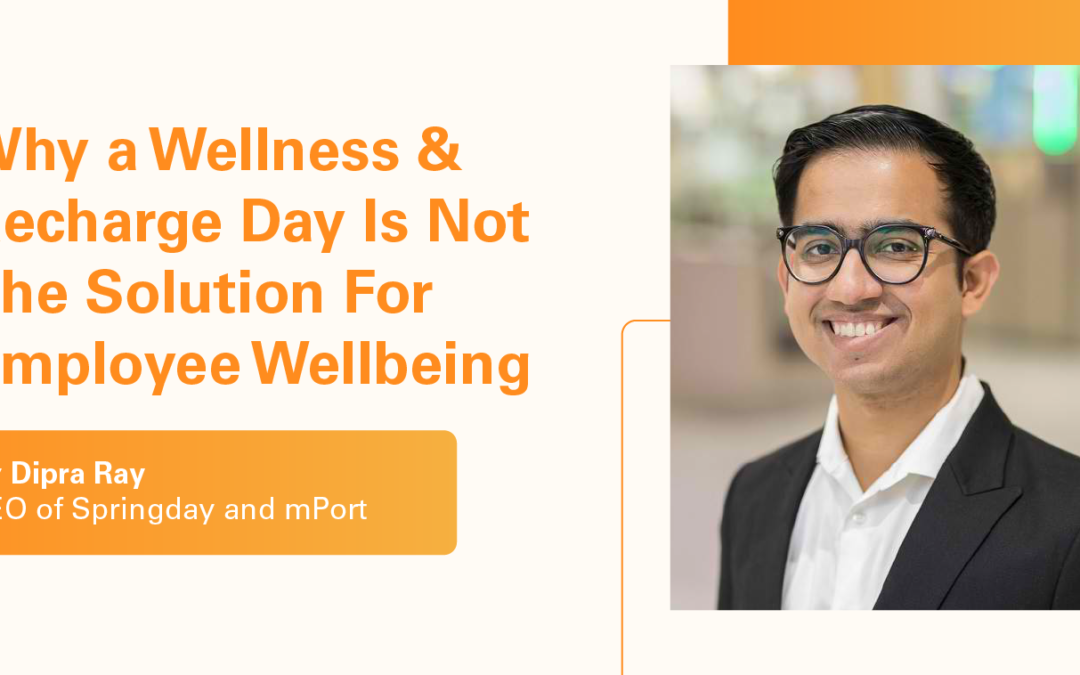IF YOU THINK A 'WELLNESS DAY' IS ENOUGH TO SUPPORT EMPLOYEE WELLBEING, THINK AGAIN.
Over the last few weeks, I’ve seen a stream of posts on LinkedIn from companies near and far announcing a workplace ‘wellness’ or ‘recharge’ day. Having seen them, I started to wonder whether I should actually have a ‘wellness’ day at mPort and Springday. I’ve had some time to reflect on this and I have an unpopular opinion: workplace wellness or recharge days don’t work – at best, they’re tokenistic and a PR stunt and worst, they can result in creating more stress at work than less.
It reminds me of my time in investment banking when we were encouraged to leave work early but on the very same day, our managers would come and drop work at 8pm expecting it to be turned around by 8am the next day.
Don’t get me wrong – I’m not saying that you shouldn’t be supporting the wellbeing of your employees, I’m saying that you should be doing more than just a company-wide wellness day.
I see it all the time. Job descriptions that emphasise how great it is that the company gives all of their staff a ‘wellness day’ – a day off to focus on their mental health. But what else are these companies doing to support the wellbeing of their workforce?
The truth is, many organisations hide behind the ‘wellness day’. They act as though they’re putting the wellbeing of their employees at the forefront of their culture. But by giving the whole company a set day off, staff are just having to fit five days of work into four days, and they’re not actually getting any real support for their mental health.
Although a day off here and there can be beneficial for a person’s wellbeing, shouldn’t they be able to choose to have this day when they really need it, not when it’s dictated from the top? And shouldn’t the company be providing more support for their employees every day, year-round?
Fundamentally, wellness days don’t work because they don’t change much of what goes on in the organisation every other day. Smaller, more meaningful changes are the real way to support the wellbeing of your employees and make a real impact on organisational culture.
Here are six meaningful changes that are far more effective for employee wellbeing than a token ‘wellness day’:
1. Create a culture of inclusion
You need to go the extra mile to create a culture where all employees feel safe and comfortable. On a broader level, simply creating space for employees to connect with their colleagues and their supervisors can make them feel more comfortable to be themselves at work and to speak up if they need help.
These shifts in culture start at the top, and managers need to lead by example. Connect with your employees on a personal level and be transparent with them. If you’re real with them, it’s likely they’ll be real with you.
Treat all employees with the same levels of respect. Give them ample opportunity to voice their feedback and feelings. Make sure that you actively listen to their concerns and take their feedback on board. Lastly, provide a supportive environment and ensure that no discrimination or bullying occurs.
2. Offer flexibility and promote work life balance
Proactively offer flexibility. Accommodating the needs of your employees doesn’t necessarily mean lowering your standards. Most often, it improves employee engagement and increases productivity.
Allow for flexible working arrangements. This could mean flexible hours, working remotely, flexibility with paid and unpaid leave, and more. Be open to identifying adjustments that will work for the employee and the business.
This is where the whole concept of a ‘wellness day’ should be given a reboot. One mental health day a year won’t solve everyone’s problems. Allow people to take mental health days as sick days when they need them. People often take mental health days anyway but hide them by saying that they have a migraine or gastro.
This is why it’s important to promote work-life balance through flexible working policies, encouraging staff to take regular breaks and limiting email hours. Much like many of the other tips here, this starts from the top down, and people in management positions should be following these policies as well (i.e., don’t email your employees about work at 9pm).
Create a culture where it’s OK for people to take a day off when they really need it, and be open about why. At mPort in particular, even prior to the pandemic, we’ve always let people take time off as and when they need it – without the need for a medical certificate or having to justify why. It creates a culture of trust, safety, and overall better health & wellbeing.
3. Increase awareness of mental health
Actively work to increase awareness of mental health within your organisation. You can do this by participating in events like World Mental Health Day and RUOK? Day, talking openly about mental health, and conducting mental health awareness programs.
It’s important to work on destigmatising mental illness, and provide a space where employees feel safe to open up. When people don’t fear stigma or discrimination, they are more likely to ask for accommodations and help when they need them.
4. Lead by example and communicate openly
Don’t just say you support wellbeing, show it. Lead by example and actively take care of your own mental health. Be transparent and show your employees what you do to manage your own wellbeing and prevent burnout.
You should also communicate openly with employees about changes within the organisation and remove daily stress where possible. You can do this by setting expectations about workloads, prioritising what’s urgent and must get done, and acknowledging what’s not as important and can slide if necessary. If employees are experiencing burnout, think about what you can do as a leader to fix this. Do you need to hire more people?
5. Evaluate your job design
One of the most frustrating things that I see happening is that all of the above can’t be fixed if you don’t actually critically evaluate the requirements of the job (known as job design). Someone who has to work 12-hour night shifts will by design struggle with sleep. Or being forced to work for insane long hours during weekdays and weekends will inevitably lead to burn out regardless of the type of wellness resource you through at it. The key to fixing this is to actually do a critical evaluation of your job design.
If your jobs require people to be working unsustainable hours or create stress inherently, re-visit the actual job scopes. This requires you to understand what’s causing the actual pain points in your business. At Springday, we’ve seen clients use data from our wellbeing surveys to actually evaluate and improve actual job design. Minor shifts such as not expecting people to respond to emails instantly or not open their computers on the weekend can make all the difference.
6. Implement regular wellbeing initiatives
Implement regular initiatives to help promote the importance of wellbeing in the workplace and engage your employees. The key word here is ‘regular’, you should be promoting wellbeing every day of the year.
Some ways to do this are to implement physical health programs or challenges, provide mental wellbeing resources, mindfulness practices, personal development opportunities, and more.
You could do this internally, or you could get somebody else to do the heavy lifting for you. A number of our clients at Springday rely on us to do the heavy lifting for them to help support the overall health and wellbeing of their staff.
In Summary
Supporting the wellbeing of your employees should be something that is deeply ingrained in the operations and culture of your organisation. If you think giving your staff one token ‘wellness day’ is enough to support their wellbeing, think again. Smaller, meaningful changes are the real hero in providing the necessary support for everyone in your company, and they will go a long way in improving productivity and employee retention as well.
You need to look after your employees to be successful, that’s the bottom line.
About Dipra Ray
Dipra Ray is the Managing Director and CEO of Springday & mPort. Both businesses sit at the forefront of technology and wellbeing, and build clever ecosystems that measure, inform and improve people’s wellbeing. He strongly believes that workplaces have a role to play in helping their employees become happier and healthier, in turn creating thriving businesses










